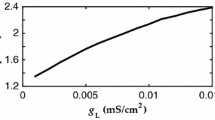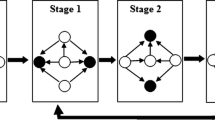Abstract
Ordinary differential equations are used to model a peculiar motor behaviour in the anomuran decapod crustacean Emerita analoga. Little is known about the neural circuitry that permits E. analoga to control the phase relationships between movements of the fourth legs and pair of uropods as it digs into sand, so mathematical models might aid in identifying features of the neural structures involved. The geometric arrangement of segmental ganglia controlling the movements of each limb provides an intuitive framework for modelling. Specifically, due to the rhythmic nature of movement, the network controlling the fourth legs and uropods is viewed as three coupled identical oscillators, one dedicated to the control of each fourth leg and one for the pair of uropods, which always move in bilateral synchrony. Systems of Morris–Lecar equations describe the voltage and ion channel dynamics of neurons. Each central pattern generator for a limb is first modelled as a single neuron and then, more realistically as a multi-neuron oscillator. This process results in high-dimensional systems of equations that are difficult to analyse. In either case, reduction to phase equations by averaging yields a two-dimensional system of equations where variables describe only each oscillator’s phase along its limit cycle. The behaviour observed in the reduced equations approximates that of the original system. Results suggest that the phase response function in the two dimensional system, together with minimal input from asymmetric bilateral coupling parameters, is sufficient to account for the observed behaviour.
Similar content being viewed by others
References
Cattaert D, Barthe JY, Neil DM, Clarac F (1992) Remote control of the swimmeret central pattern generator in crayfish (Procambarus clarkii and Pacifistacus leniusculus): effect of a walking leg proprioceptor. J Exp Biol 169:181–206
Ermentrout GB (2002) Simulating, analyzing, and animating dynamical systems: a guide to XPPAUT for researchers and students. SIAM, Philadelphia
Ermentrout GB, Kopell N (1991) Multiple pulse interactions and averaging in systems of coupled neural oscillators. J Math Biol 29:195–217
Faulkes Z, Paul DH (1997a) Digging in sand crabs (Decapoda, Anomura, Hippoidea): interleg coordination. J Exp Biol 200:793–805
Faulkes Z, Paul DH (1997b) Coordination between the legs and tail during digging and swimming in sand crabs. J Comp Physiol A 180:161–169
Fenichel N (1971) Persistence and smoothness of invariant manifolds for flows. Indiana Univ Math J 21:193–226
Friesen WO, Chang J (2001) Sensory and central mechanisms control intersegmental coordination. Curr Opin Neurobiol 11:678–683
Golubitsky M, Stewart I (1985) Hopf Bifurcation in the presence of symmetry. Arch Rational Mech Anal 87:107–165
Golubitsky M, Stewart I (1986) Hopf bifurcation with dihedral group symmetry: coupled nonlinear oscillators. Contemp Math 56: 131–173
Golubitsky M, Stewart I, Schaeffer DG (1985) Singularities and groups in bifurcation theory, vol 2. Springer, Berlin Heidelberg New York
Guckenheimer J, Holmes P (1997) Nonlinear oscillations, dynamical systems and bifurcations of vector fields. Springer, Berlin Heidelberg New York
Hodge A (2003) Modeling central pattern generators in sand crabs. M.Sc. thesis, Department of Mathematics and Statistics, University of Victoria, Victoria
Hodgkin AL, Huxley AF (1952) A quantitative description of membrane current and its application to conduction and excitation in nerve. J Physiol 117:500–544
Hooper SL, DiCaprio RA (2004) Crustacean motor pattern generator networks. Neurosignals 13:50–69
Izhikevich EM (2000) Phase equations for relaxation oscillators. SIAM J Appl Math 60:1789–1805
Kopell N, Ermentrout GB (1990) Phase transitions and other phenomena in chains of coupled oscillators. SIAM J Appl Math 50:1014–1052
Kopell N, Ermentrout GB, Williams TL (1991) On chains of oscillators forced at one end. SIAM J Appl Math 51:1397–1417
Morris C, Lecar H (1981) Voltage oscillations in the barnacle giant muscle fiber. Biophys J 35:305–317
Mulloney B, Hall WM (2000) Functional organization of crayfish abdominal ganglia III Swimmeret motor neurons. J Comp Neurol 419:233–243
Murchison D, Chrachiri A, Mulloney B (1993) A separate local pattern-generating circuit controls the movement of each swimmeret in crayfish. J Neurophysiol 70:2620–2631
Paul DH (1979) An endogenous motor program for sand crab uropods. J Neurobiol 10:273–289
Paul DH (2004) Projection and local interneurons in the sixth abdominal ganglion of the sand crab Emerita analoga (Hippidae). J Comp Neurol 480:310–329
Paul DH, Faulkes Z, Antonsen BL (2002) Synergies between disparate motor systems: loci for behavioural evolution. In: Wiese K (eds) Crustacean experimental systems in neurobiology. Springer, Berlin Heidelberg New York, pp 263–282
Paul DH, Mulloney B (1985a) Local interneurons in the swimmeret system of the crayfish. J Comp Physiol A 156:489–502
Paul DH, Mulloney B (1985b) Nonspiking local interneuron in the motor pattern generator for the crayfish swimmeret. J Neurophysiol 54:28–39
Paul DH, Mulloney B (1986) Intersegmental coordination of swimmeret rhythms in isolated nerve cords of crayfish. J Comp Physiol A 158:215–224
Rand RH, Holmes PJ (1980) Bifurcation of periodic motions in two weakly coupled van der Pol oscillators. J Non-Linear Mech 15:387–399
Skinner FK, Kopell N, Marder E (1994) Mechanisms for oscillation and frequency control in reciprocally inhibitory model neural networks. J Comput Neurosci 1:69–87
Skinner FK, Kopell N, Mulloney B (1997) How does the crayfish swimmeret system work? Insights from nearest neighbour coupled oscillator models. J Comput Neurosci 4:151–160
Skinner FK, Mulloney B (1998) Intersegmental coordination of limb movements during locomotion: Mathematical models predict circuits that drive swimmeret beating. J Neurosci 18:3831–3842
Skinner FK, Turrigiano GG, Marder E (1993) Frequency and burst duration in oscillating neurons and two cell networks. Biol Cybern 69:375–383
Tschulum N, Hall WM, Mulloney B (2001) Limb movements during locomotion: Test of a model of an intersegmental coordinating circuit. J Neurosci 21:7859–7869
Author information
Authors and Affiliations
Corresponding author
Rights and permissions
About this article
Cite this article
Hodge, A., Edwards, R., Paul, D.H. et al. Neuronal Network Models of Phase Separation Between Limb CPGs of Digging Sand Crabs. Biol Cybern 95, 55–68 (2006). https://doi.org/10.1007/s00422-006-0065-9
Received:
Accepted:
Published:
Issue Date:
DOI: https://doi.org/10.1007/s00422-006-0065-9




